
S&P 500
Upwards movement for the week continues as expected, and it has support from rising market breadth and declining volatility. The Elliott wave counts remain the same.
Summary: The next short-term target is at 3,058. Look for corrections to continue to be very shallow and brief. Use the lower edge of the best fit channel as a support guide.
The mid-term target remains at 3,104 for a more time consuming consolidation or pullback, which may also be shallow.
The biggest picture, Grand Super Cycle analysis, is here.
Monthly charts were last published here, with video here. There are two further alternate monthly charts here. Video is here.
ELLIOTT WAVE COUNTS
The two Elliott wave counts below will be labelled First and Second. They may be about of even probability. When the fifth wave currently unfolding on weekly charts may be complete, then these two wave counts will diverge on the severity of the expected following bear market. To see an illustration of this future divergence monthly charts should be viewed.
FIRST WAVE COUNT
WEEKLY CHART
The basic Elliott wave structure consists of a five wave structure up followed by a three wave structure down (for a bull market). This wave count sees the bull market beginning in March 2009 as an incomplete five wave impulse and now within the last fifth wave, which is labelled cycle wave V. This impulse is best viewed on monthly charts. The weekly chart focusses on the end of it.
Elliott wave is fractal. This fifth wave labelled cycle wave V may end a larger fifth wave labelled Super Cycle wave (V), which may end a larger first wave labelled Grand Super Cycle wave I.
The teal Elliott channel is drawn using Elliott’s first technique about the impulse of Super Cycle wave (V). Draw the first trend line from the end of cycle wave I (off to the left of the chart, the weekly candlestick beginning 30th November 2014) to the end of cycle wave III, then place a parallel copy on the end of cycle wave II. This channel perfectly shows where cycle wave IV ended at support. The strongest portion of cycle wave III, the end of primary wave 3, overshoots the upper edge of the channel. This is a typical look for a third wave and suggests the channel is drawn correctly and the way the impulse is counted is correct.
Within Super Cycle wave (V), cycle wave III is shorter than cycle wave I. A core Elliott wave rule states that a third wave may never be the shortest. For this rule to be met in this instance, cycle wave V may not be longer in length than cycle wave III. This limit is at 3,477.39.
The structure of cycle wave V is focussed on at the daily chart level below.
Within cycle wave V, primary waves 1 and 2 may now be complete. Within primary wave 3, no second wave correction may move beyond its start below 2,728.81.
In historic analysis, two further monthly charts have been published that do not have a limit to upwards movement and are more bullish than this wave count. Members are encouraged to consider those possibilities (links below summary) alongside the wave counts presented on a daily and weekly basis.
DAILY CHART
Cycle wave V must subdivide as a five wave motive structure. Within that five wave structure, primary waves 1 and 2 may be complete.
Primary wave 3 must move above the end of primary wave 1 (this rule has now been met). Primary wave 3 may only subdivide as an impulse. Within the impulse, intermediate waves (1) and (2) may be complete.
Intermediate wave (3) may only subdivide as an impulse. Within intermediate wave (3), no second wave correction may move beyond its start below 2,912.99.
When primary wave 3 is over, then primary wave 4 may be a shallow sideways consolidation.
Thereafter, primary wave 5 should move above the end of primary wave 3 to avoid a truncation.
Primary wave 1 lasted 86 sessions, 3 short of a Fibonacci 89. Primary wave 2 lasted 22 sessions, 1 longer than a Fibonacci 21. Primary wave 3 may end about a Fibonacci 55 sessions, give or take two or three sessions either side. This is a rough guideline only.
So far primary wave 3 has lasted 23 sessions.
Corrections within primary wave 3 so far have found support at the lower edge of the grey best fit channel.
SECOND WAVE COUNT
WEEKLY CHART
This weekly chart is almost identical to the first weekly chart, with the sole exception being the degree of labelling.
This weekly chart moves the degree of labelling for the impulse beginning in March 2009 all down one degree. This difference is best viewed on monthly charts.
The impulse is still viewed as nearing an end; a fifth wave is still seen as needing to complete higher. This wave count labels it primary wave 5.
TECHNICAL ANALYSIS
WEEKLY CHART
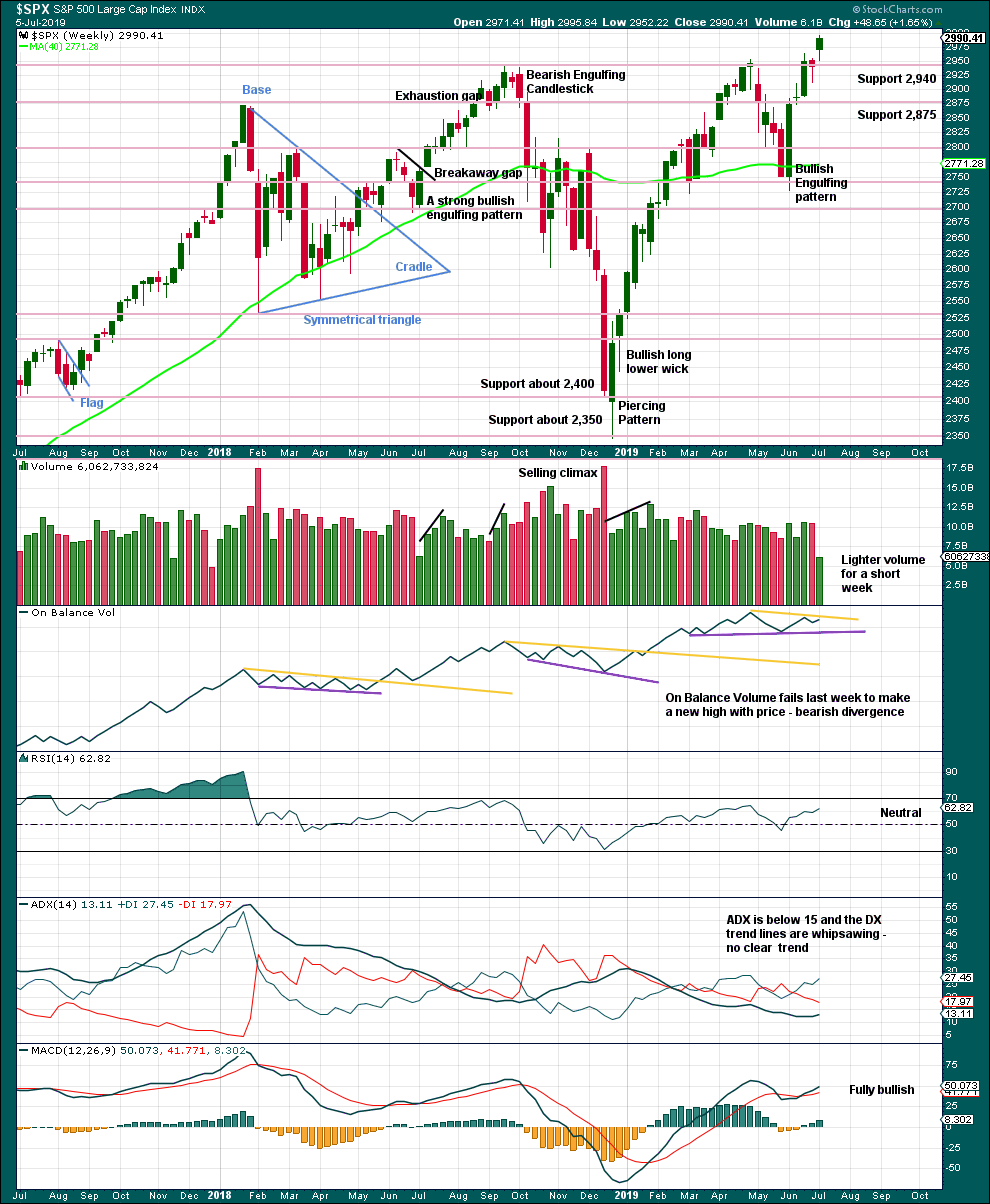
Click chart to enlarge. Chart courtesy of StockCharts.com.
The long lower wick on this weekly candlestick suggests more upwards movement next week.
DAILY CHART
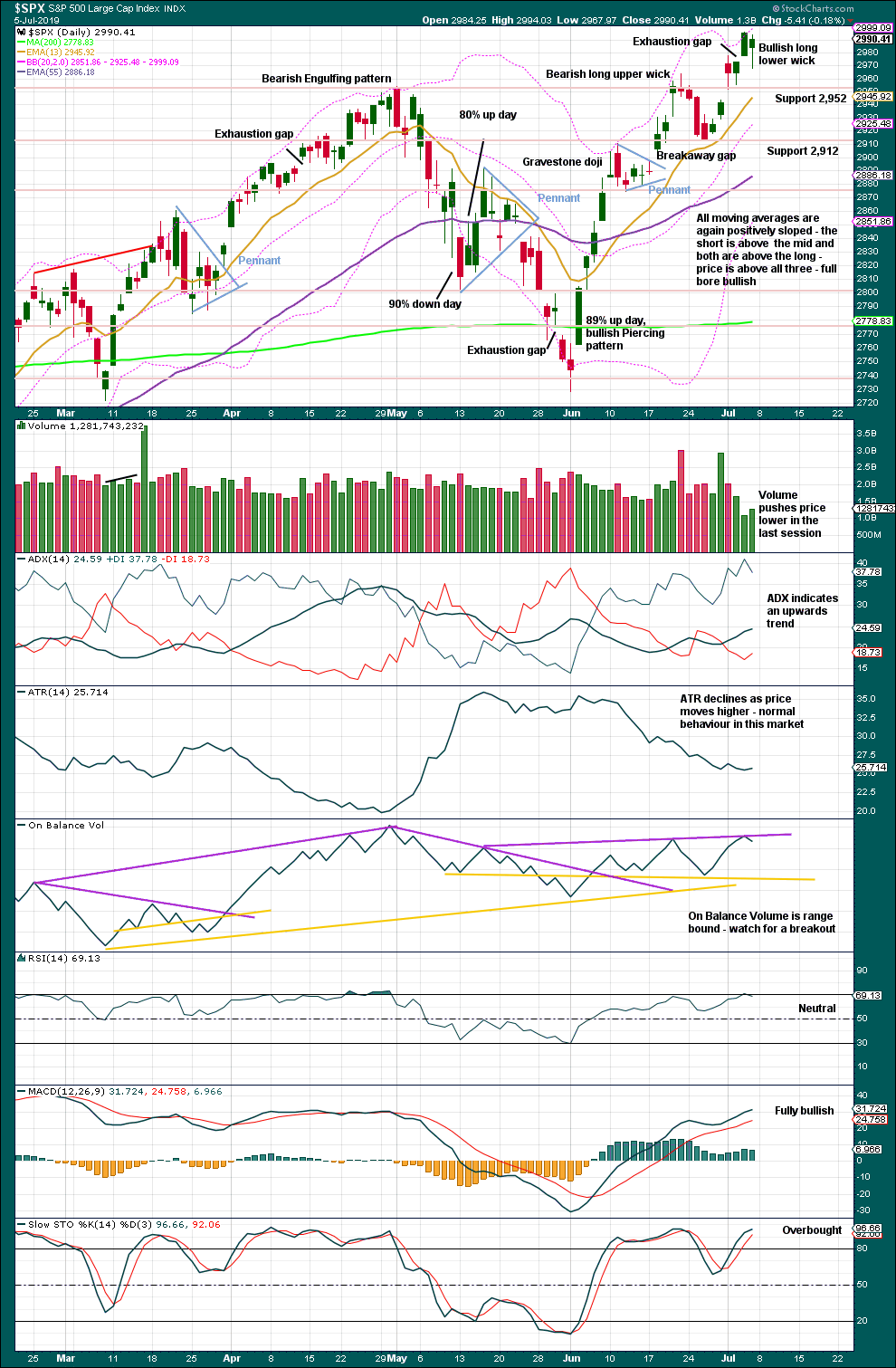
Click chart to enlarge. Chart courtesy of StockCharts.com.
Rising price on light and declining volume has been a feature of this market now for years at all time frames. While some support from volume is expected as likely for the Elliott wave count which expects the middle of a third wave may be unfolding, it is not necessary to see in current market conditions.
For the short term, there may be a slightly elevated risk of another pullback or consolidation developing: the last gap is now closed (now relabelled an exhaustion gap), volume pushed price lower on Friday, and On Balance Volume turned down from resistance.
However, the long lower wick on Friday’s candlestick is bullish and the trend is not extreme. RSI is back into neutral territory. There is room for the upwards trend to continue further until a more sizeable consolidation or pullback may be expected.
BREADTH – AD LINE
WEEKLY CHART
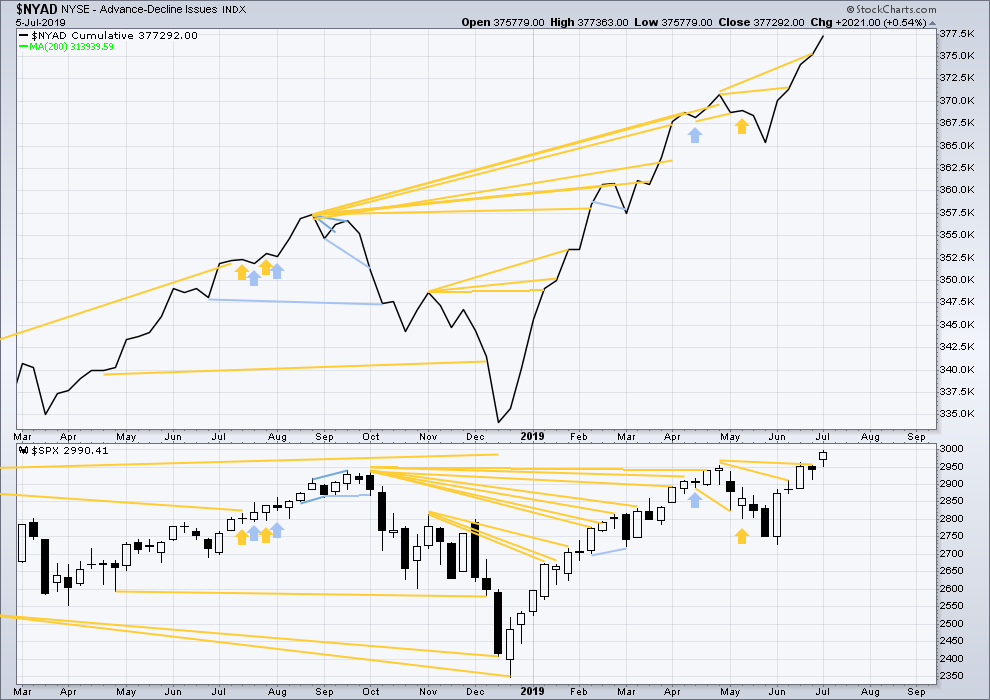
Click chart to enlarge. Chart courtesy of StockCharts.com. So that colour blind members are included, bearish signals
will be noted with blue and bullish signals with yellow.
Bear markets from the Great Depression and onwards have been preceded by an average minimum of 4 months divergence between price and the AD line with only two exceptions in 1946 and 1976. With the AD line making new all time highs again this week, the end of this bull market and the start of a new bear market is very likely a minimum of 4 months away, which is early November 2019.
In all bear markets in the last 90 years there is some positive correlation (0.6022) between the length of bearish divergence and the depth of the following bear market. No to little divergence is correlated with more shallow bear markets. Longer divergence is correlated with deeper bear markets.
If a bear market does develop here, it comes after no bearish divergence. It would therefore more likely be shallow.
This week both price and the AD line make new all time highs. Upwards movement in price has good support from rising market breadth. This is bullish.
This week only large caps have made new all time highs. Mid caps are a little way off and small caps are lagging. This is normal behaviour in the later stages of a bull market.
DAILY CHART
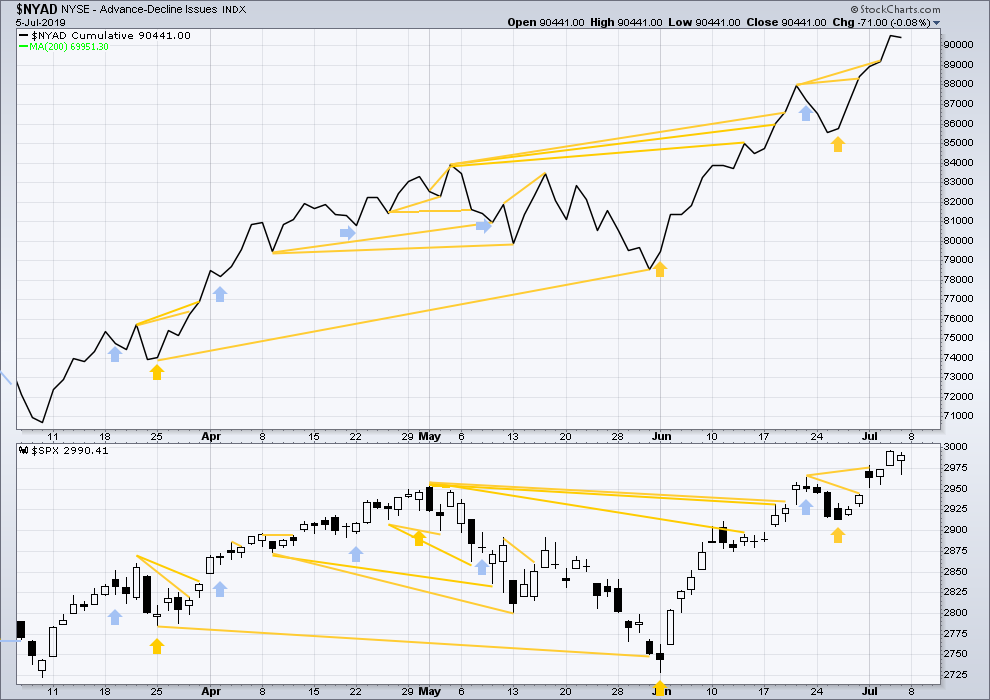
Click chart to enlarge. Chart courtesy of StockCharts.com. So that colour blind members are included, bearish signals
will be noted with blue and bullish signals with yellow.
Breadth should be read as a leading indicator.
Both the AD line and price moved a little lower on Friday. There is no divergence.
VOLATILITY – INVERTED VIX CHART
WEEKLY CHART
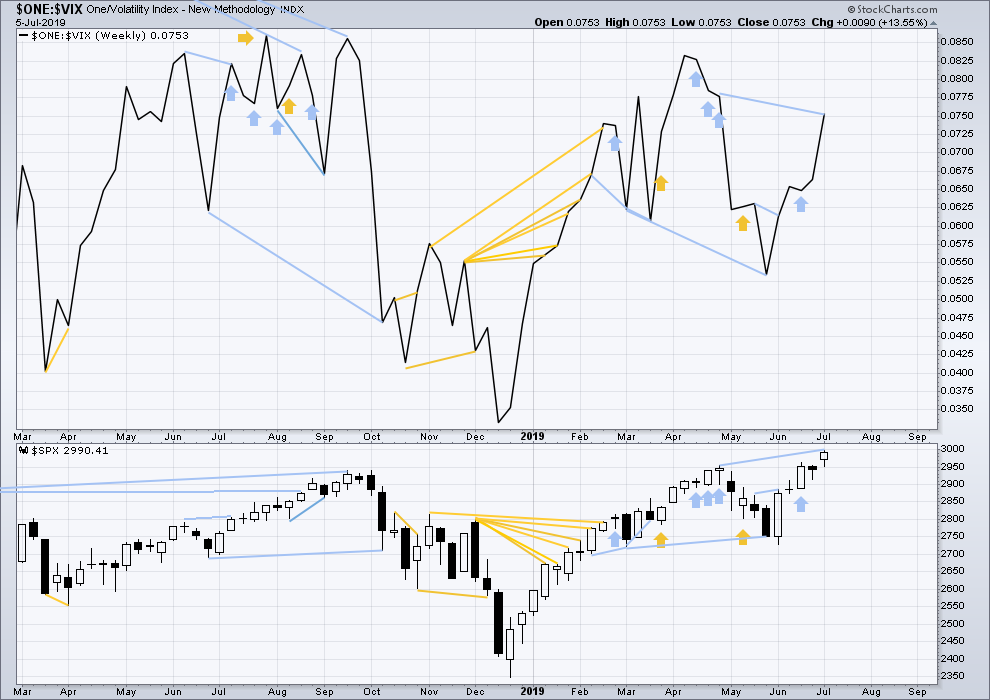
Click chart to enlarge. Chart courtesy of StockCharts.com. So that colour blind members are included, bearish signals
will be noted with blue and bullish signals with yellow.
Long-term bearish divergence remains. It may develop further before the upwards trend ends.
This week both price and inverted VIX have moved higher, but price has made new all time highs while inverted VIX has not. There is short, mid and long-term bearish divergence now between price and VIX.
DAILY CHART
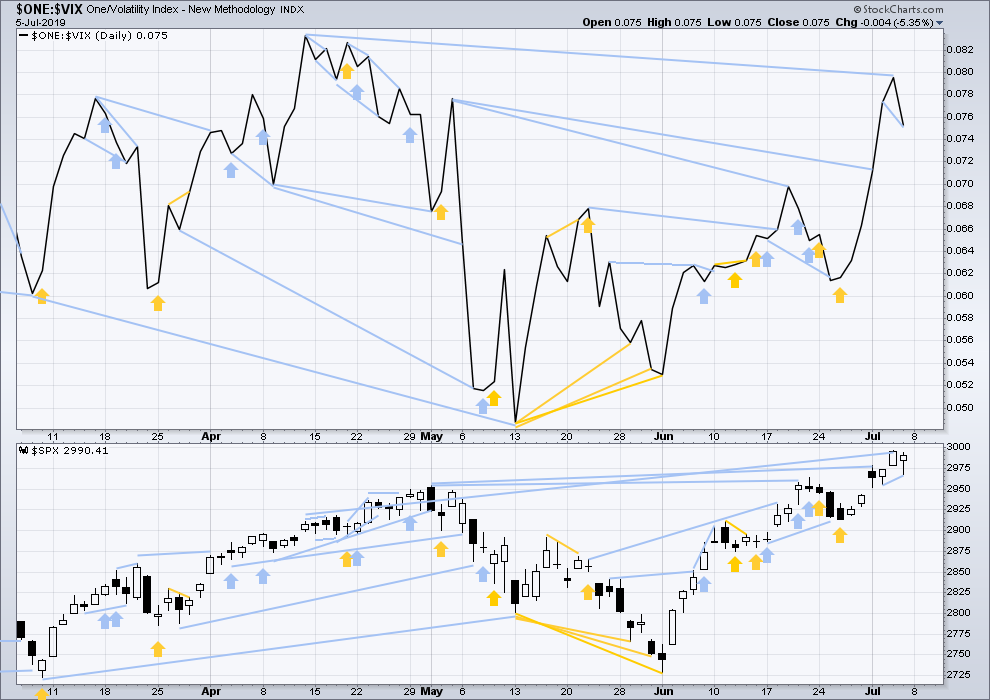
Click chart to enlarge. Chart courtesy of StockCharts.com. So that colour blind members are included, bearish signals
will be noted with blue and bullish signals with yellow.
For Friday both price and inverted VIX have moved lower. Inverted VIX has made a new short-term low below the prior low of the 2nd of July, but price has not. This divergence is bearish for the short term, but it will not be given weight in this analysis.
DOW THEORY
Dow Theory confirmed a bear market in December 2018. This does not necessarily mean a bear market at Grand Super Cycle degree though; Dow Theory makes no comment on Elliott wave counts. On the 25th of August 2015 Dow Theory also confirmed a bear market. The Elliott wave count sees that as part of cycle wave II. After Dow Theory confirmation of a bear market in August 2015, price went on to make new all time highs and the bull market continued.
DJIA: 23,344.52 – a close on the 19th of December at 23,284.97 confirms a bear market.
DJT: 9,806.79 – price has closed below this point on the 13th of December.
S&P500: 2,532.69 – a close on the 19th of December at 2,506.96 provides support to a bear market conclusion.
Nasdaq: 6,630.67 – a close on the 19th of December at 6,618.86 provides support to a bear market conclusion.
With all the indices having moved higher following a Dow Theory bear market confirmation, Dow Theory would confirm a bull market if the following highs are made:
DJIA: 26,951.81 – a new all time high has been made on the 3rd of July 2019.
DJT: 11,623.58
S&P500: 2,940.91 – a new all time high has been made on the 29th of April 2019.
Nasdaq: 8,133.30 – a new high has been made on 24th of April 2019.
GOLD
A strong downwards session to end the week favours the bearish Elliott wave count, but price has not yet invalidated any of the three daily charts published for members.
Summary: A strong downwards day for Friday with a strong push from volume suggests the back test may be incomplete (or the bearish Elliott wave count may be correct). Look out now for another test of support to relieve extreme conditions. Support is about 1,360 to 1,385.
If price breaks back below support with some strength next week, that would favour the bearish Elliott wave count. The target would then be at 1,345 for the short term.
The bullish wave count has a long-term target at 1,693 for cycle wave III to end.
A new low by any amount at any time frame now below 1,346.45 would invalidate the bullish wave count and give confidence to the bearish wave count.
Grand SuperCycle analysis is here.
Last monthly charts are here. Video is here.
Overall, the bearish wave counts still have a higher probability based upon Elliott wave structures. However, it would be best to leave price to invalidate either the bullish or bearish scenario before having confidence in which is correct.
BEARISH ELLIOTT WAVE COUNTS
FIRST WEEKLY CHART
A note about the price spike on this data from Barchart for 3rd July: I have emailed Barchart to ask them to check their data feed. I expect this is a corruption of data and should be fixed prior to next analysis. Because of the extreme nature of this particular spike I am choosing to ignore it in today’s analysis. However, if it remains and if Barchart tell me it is correct, then it would be included in the analysis.
Note: The price spike visible on daily and weekly charts is not visible on time frames lower than daily. It is for this reason that the spike is highly suspicious and is today ignored.
It remains possible that the bear market for Gold may yet continue when cycle wave b is complete, and it is possible that cycle wave b may be complete at the high. Cycle wave b may be a double zigzag.
Double zigzags are common structures, but within them their X waves are almost always single zigzags that are relatively brief and shallow. However, X waves may be any corrective structure, including a multiple.
The maximum number of corrective structures in a multiple is three. This count of three refers to W, Y and Z. To label any one of W, Y or Z as multiples violates this Elliott wave rule. However, X waves may be labelled as multiples and here the rule is met. X waves do occasionally subdivide as multiples.
This wave count sees primary wave X as a complete double combination: zigzag – X – expanded flat.
Primary wave Y may be a complete zigzag. The purpose of a second zigzag in a double zigzag is to deepen the correction when the first zigzag does not move price far enough. This purpose has been achieved.
A new low now by any amount at any time frame below 1,346.45 would invalidate the bullish wave count below and provide some confidence in this wave count.
DAILY CHART
This chart focusses on the impulse of intermediate wave (C).
Intermediate wave (C) may be a complete impulse; the structure may now be complete at all time frames. There is a bearish candlestick reversal pattern on StockCharts data.
This wave count now requires a new low below 1,346.45 for confidence.
SECOND DAILY CHART
It is also possible that intermediate wave (C) may be an incomplete impulse and the last several sessions may be another correction within an ongoing upwards trend.
A target is calculated for minor wave 5 to end. About this target intermediate wave (C) would also be closer to equality in length with intermediate wave (A).
BULLISH ELLIOTT WAVE COUNT
WEEKLY CHART
This wave count sees the the bear market complete at the last major low for Gold in November 2015.
If Gold is in a new bull market, then it should begin with a five wave structure upwards on the weekly chart. However, the biggest problem with this wave count is the structure labelled cycle wave I because this wave count must see it as a five wave structure, but it looks more like a three wave structure.
Commodities often exhibit swift strong fifth waves that force the fourth wave corrections coming just prior and just after to be more brief and shallow than their counterpart second waves. It is unusual for a commodity to exhibit a quick second wave and a more time consuming fourth wave, and this is how cycle wave I is labelled. This wave count still suffers from this very substantial problem, and for this reason two bearish wave counts are still considered above as they have a better fit in terms of Elliott wave structure.
Cycle wave II subdivides well as a double combination: zigzag – X – expanded flat.
Cycle wave III may have begun. Within cycle wave III, primary waves 1 and 2 may now be complete. If it continues lower as a double zigzag, then primary wave 2 may not move beyond the start of primary wave 1 below 1,160.75.
Cycle wave III so far for this wave count would have been underway now for 45 weeks. It may be beginning to exhibit some support from volume and increasing ATR. If this increase continues, then this wave count would have some support from technical analysis.
Draw an acceleration channel about primary waves 1 and 2: draw the first trend line from the end of primary wave 1 to the last high, then place a parallel copy on the end of primary wave 2. Keep redrawing the channel as price continues higher. When primary wave 3 is complete, then this channel would be drawn using Elliott’s first technique about the impulse. The lower edge may provide support.
Primary wave 4 may not move into primary wave 1 price territory below 1,346.45.
DAILY CHART
This daily chart focusses on the impulse of primary wave 3.
Primary wave 3 may only subdivide as an impulse. Primary wave 3 has now moved above the end of primary wave 1, meeting a core Elliott wave rule.
When it arrives, primary wave 4 may not move into primary wave 1 price territory below 1,346.45.
Intermediate wave (5) may exhibit further strength. The target for primary wave 3 is calculated using the most common Fibonacci ratio to primary wave 1.
The structure of primary wave 3 as an incomplete impulse for this wave count is seen in exactly the same way as the incomplete impulse for intermediate wave (C) in the second bearish daily chart.
Look out now for the possibility of another blow off top as intermediate wave (5) to end primary wave 3 comes to an end.
TECHNICAL ANALYSIS
MONTHLY CHART
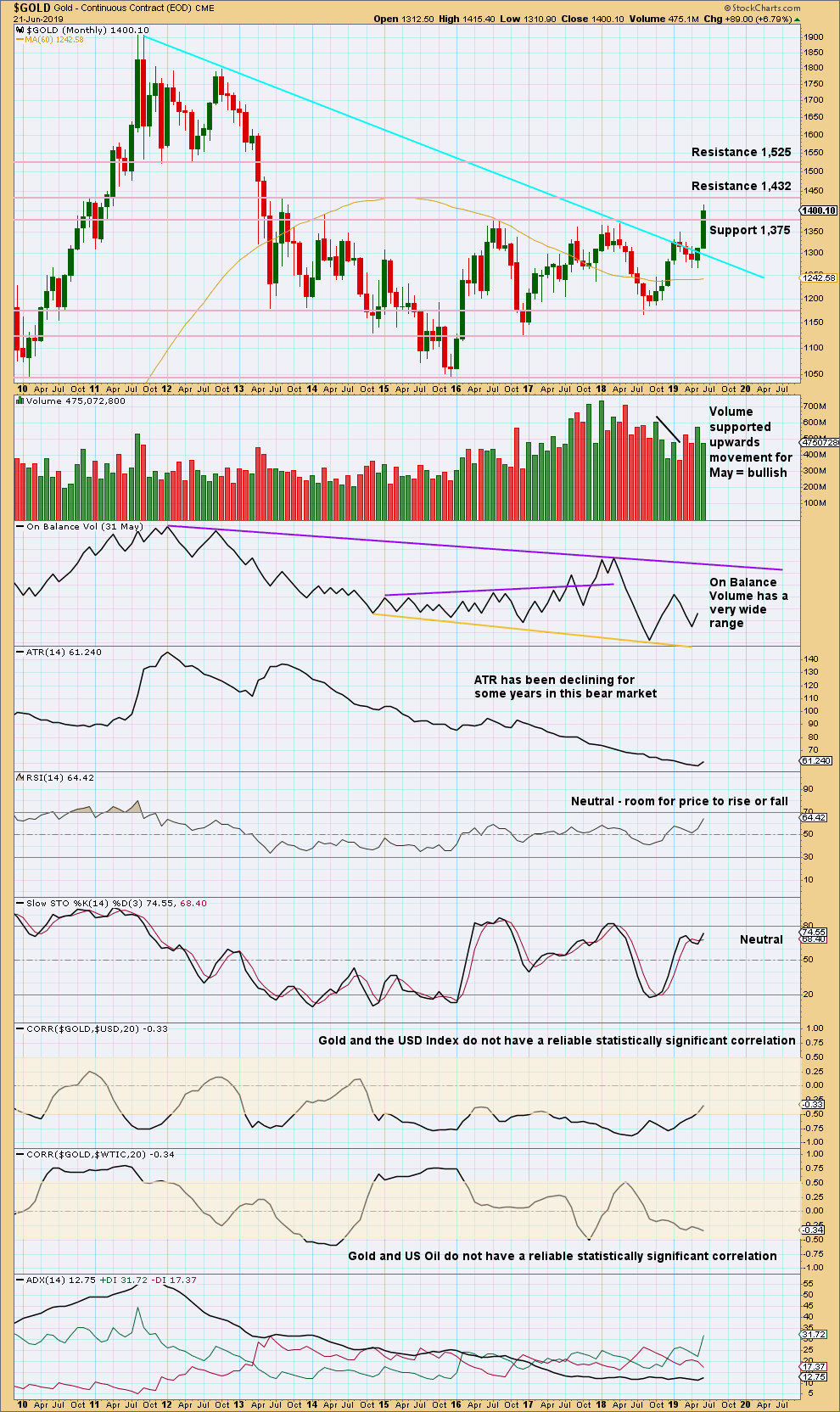
Click chart to enlarge. Chart courtesy of StockCharts.com.
Gold has effected an upwards breakout above multi-year resistance and above the cyan bear market trend line. Look for next resistance identified on the chart.
WEEKLY CHART
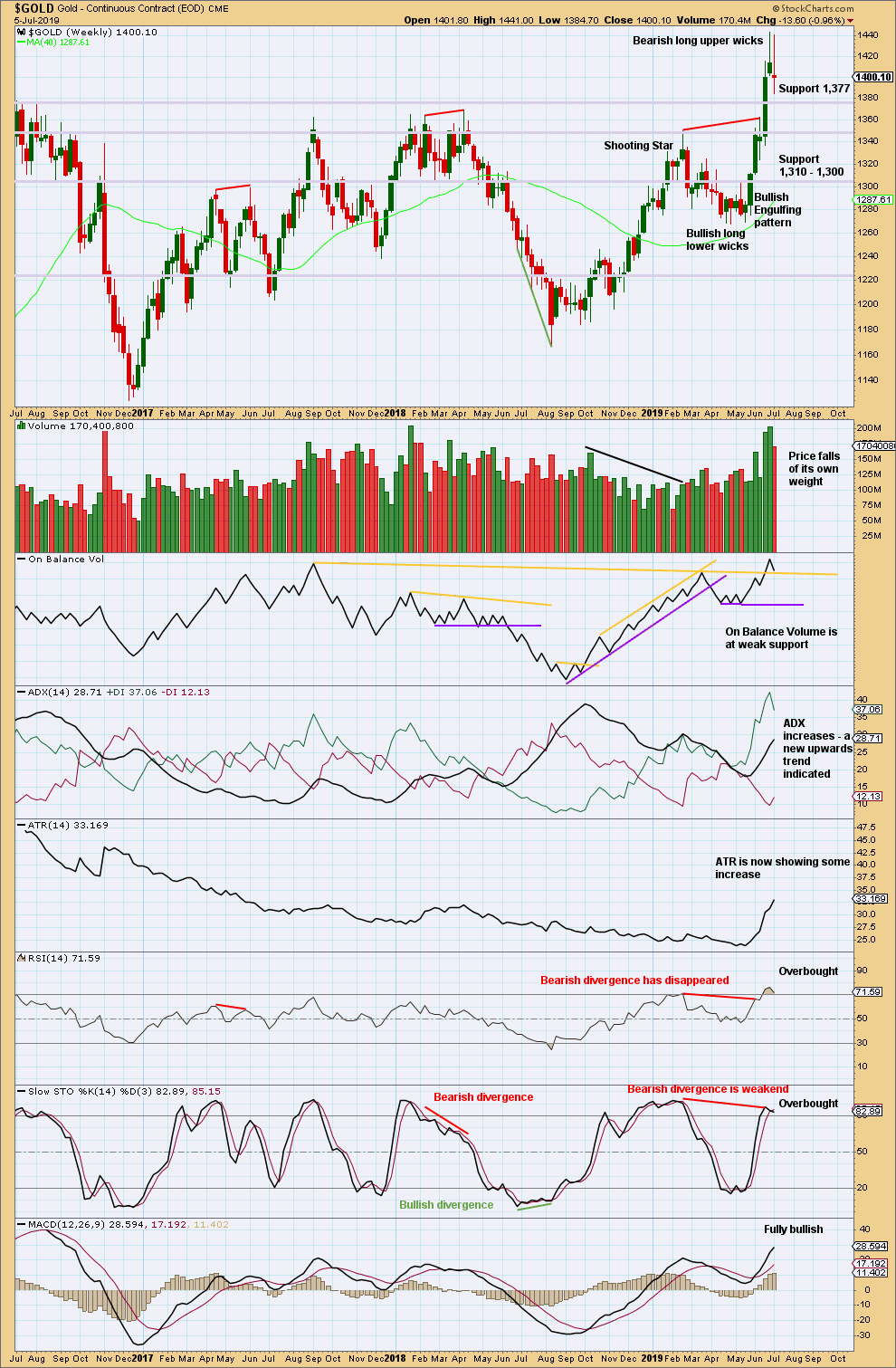
Click chart to enlarge. Chart courtesy of StockCharts.com.
Gold has broken out of a multi-year consolidation, which saw resistance about 1,375. The breakout has support from volume, so confidence may be had in it.
Price now has some strength with rising ATR. Conditions remain overbought. The pullback so far has not relieved extreme conditions and has lasted only one week. It may continue a little longer.
Look now for strong support about 1,375.
DAILY CHART
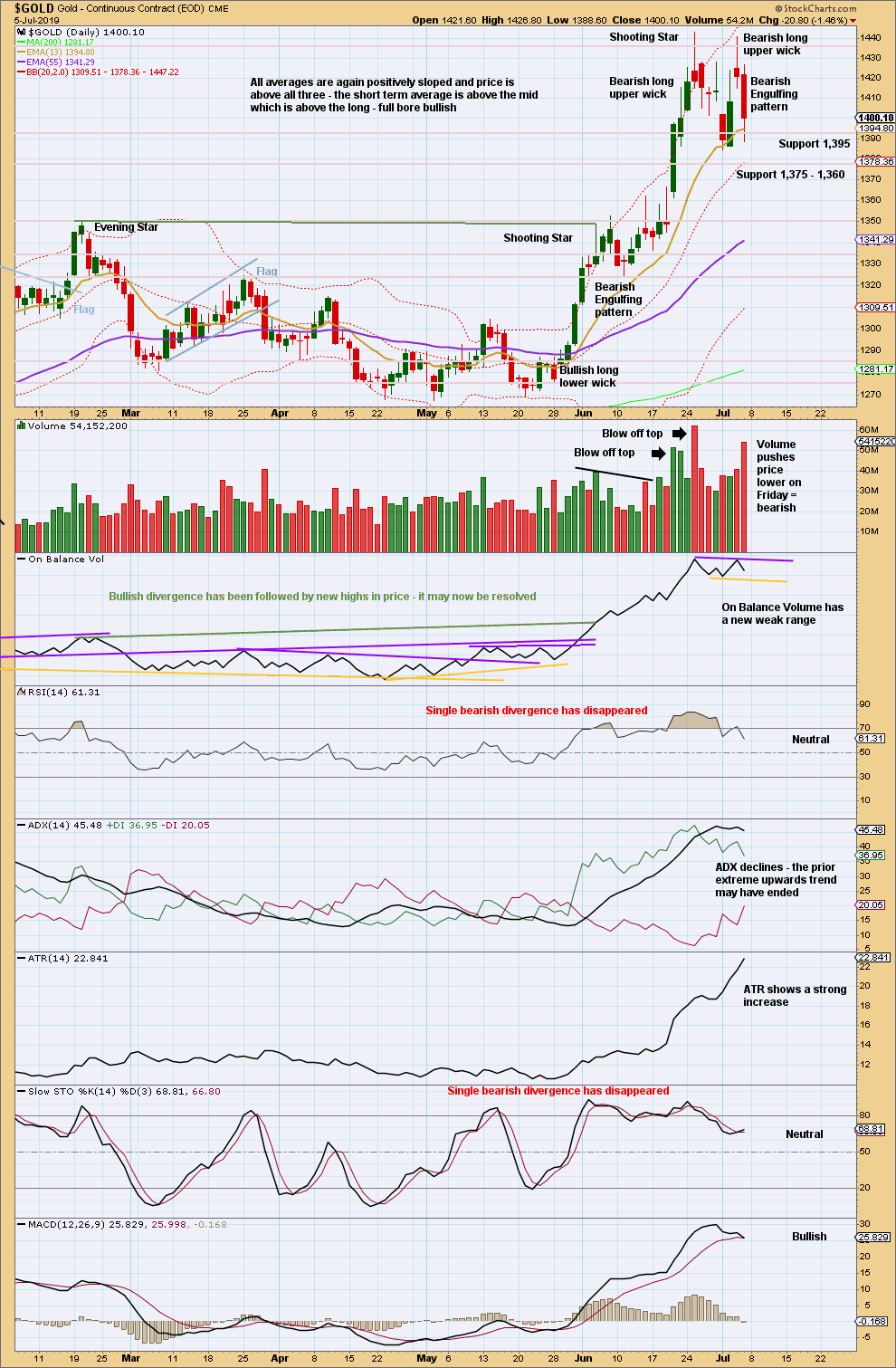
Click chart to enlarge. Chart courtesy of StockCharts.com.
It is common to see price curve down and back test support at prior resistance after a breakout. After strong downwards movement on Friday, it now looks like the back test may continue.
Overall, this chart is bullish and supports the bullish Elliott wave count.
GDX WEEKLY CHART
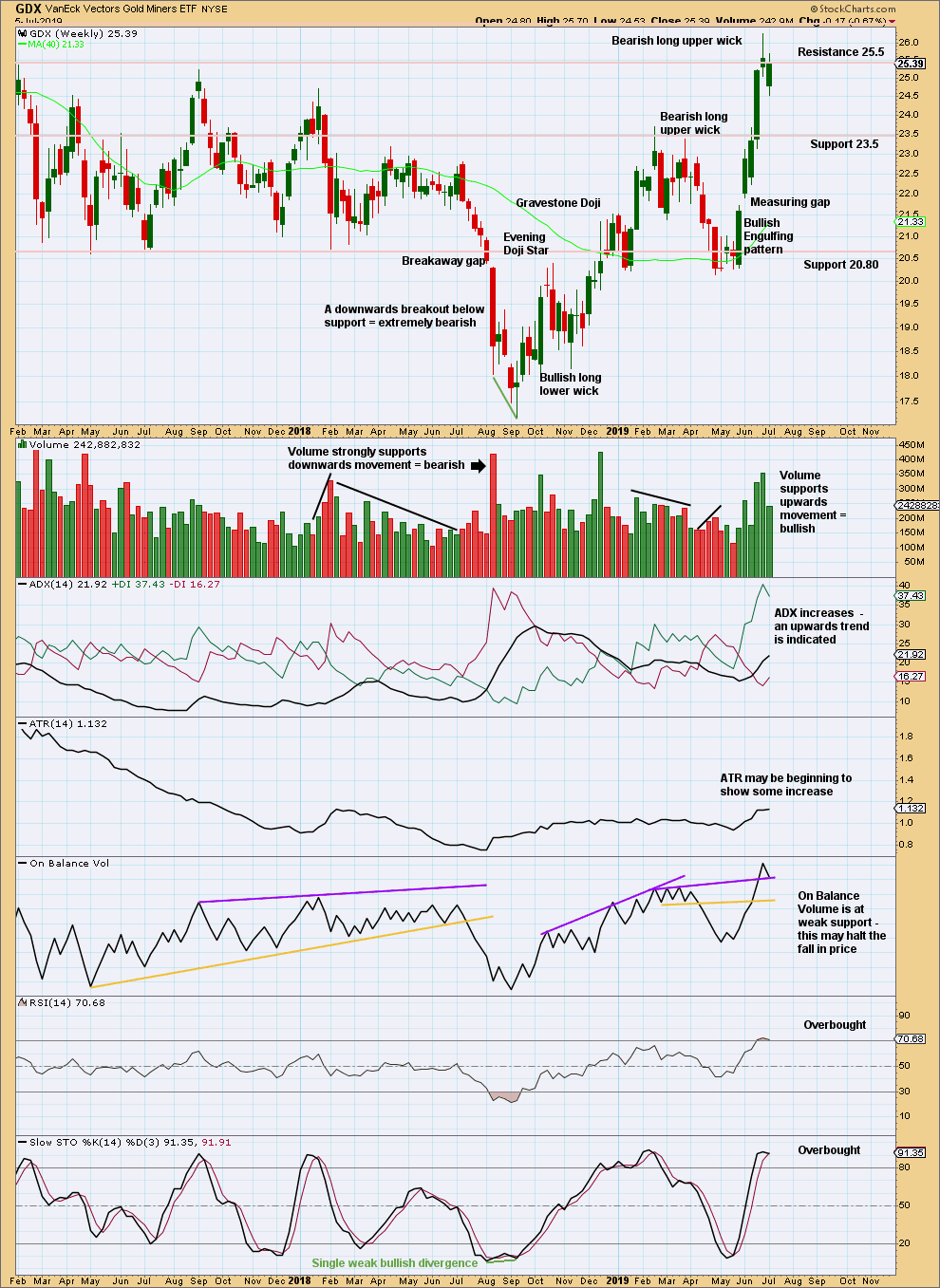
Click chart to enlarge. Chart courtesy of StockCharts.com.
The upwards trend continues, but conditions are now overbought. This can continue for a while during a strong trend. At this stage, there are no signs of a reversal.
GDX DAILY CHART

Click chart to enlarge. Chart courtesy of StockCharts.com.
The measuring gap remains open as long as price remains above 24.03. Closure of this gap would be a significant bearish signal.
For the short term, volume suggests more downwards movement next week.
US OIL
Some sideways or downwards movement was expected for the week. An outside week closes red, meeting expectations overall.
Summary: The bounce may end now next week or possibly the week after at a target zone from 60.53 to 61.74. If price comes up to touch the upper edge of the maroon channel, then it should find strong resistance there and end the bounce.
The larger trend most likely still remains down. The final target is calculated at 10.72.
MAIN ELLIOTT WAVE COUNT
MONTHLY CHART
The basic Elliott wave structure is five steps forward and three steps back. This Elliott wave count expects that US Oil is still within a three steps back pattern, which began in July 2008. The Elliott wave count expects that the bear market for US Oil continues.
This Elliott wave corrective structure is a double zigzag, which is a fairly common structure. The correction is labelled Super Cycle wave (II).
The first zigzag in the double is complete and labelled cycle wave y. The double is joined by a three in the opposite direction labelled cycle wave x, which subdivides as a zigzag. The second zigzag in the double may now have begun, labelled cycle wave w.
The purpose of a second zigzag in a double zigzag is to deepen the correction when the first zigzag does not move price deep enough. To achieve this purpose cycle wave y may be expected to move reasonably below the end of cycle wave w at 26.06. The target calculated would see this expectation met.
Cycle wave y is expected to subdivide as a zigzag, which subdivides 5-3-5.
Cycle wave w lasted 7.6 years and cycle wave x lasted 2.7 years. Cycle wave y may be expected to last possibly about a Fibonacci 5 or 8 years.
If it continues higher, then primary wave B may not move beyond the start of primary wave A above 76.90.
The upwards wave labelled cycle wave x would have to be counted as a five wave impulse to see US Oil as within a new bull market. Such a wave count could be made but would look forced. This wave subdivides best as a three.
WEEKLY CHART
This weekly chart is focussed on the start of cycle wave y.
Cycle wave y is expected to subdivide as a zigzag. A zigzag subdivides 5-3-5. Primary wave A must subdivide as a five wave structure if this wave count is correct.
Primary wave A may be a complete five wave impulse at the last low.
Primary wave B may now be a complete single zigzag at the last high.
Primary wave C may have just begun. Primary wave C must subdivide as a five wave structure.
Primary wave A lasted 12 weeks, just one short of a Fibonacci 13.
Primary wave C may be longer in time as well as price. If cycle wave y lasts a Fibonacci 5 years, then primary wave C within it may take as long as a Fibonacci 233 weeks.
Intermediate wave (1) within primary wave C may be a complete impulse. Intermediate wave (2) may not move beyond the start of intermediate wave (1) above 66.59.
Draw a channel about the zigzag of primary wave y using Elliott’s technique for a correction. Draw the first trend line from the start of primary wave A to the end of primary wave B, then place a parallel copy on the end of primary wave A. The upper edge of this channel may show where bounces along the way down find resistance. The lower edge of the channel may provide support.
If intermediate wave (2) does come up to touch the upper edge of the maroon channel, then that may offer an opportunity to join the downwards trend.
DAILY CHART
Note that monthly and weekly charts are on a semi-log scale, but this daily chart is on an arithmetic scale. This makes a slight difference to trend channels.
It is possible that intermediate wave (1) is complete. Minor wave 4 for this wave count exhibits some alternation to minor wave 2; minor wave 2 may be a relatively deep zigzag or flat, and minor wave 4 may be a more shallow zigzag.
Minor wave 5 ends with a slight 0.11 truncation.
Intermediate wave (2) would most likely unfold as a zigzag and may end either about the 0.618 Fibonacci ratio of intermediate wave (1) or about the upper edge of the maroon Elliott channel. Intermediate wave (2) may continue for another week or possibly two.
Intermediate wave (2) may not move beyond the start of intermediate wave (1) above 66.59.
Within the zigzag of intermediate wave (2), minor wave A may now be a complete five wave impulse and minor wave B may be a complete expanded flat. If minor wave A is correctly labelled as a five and if minor wave B continues lower, then minor wave B may not move beyond the start of minor wave A, below 50.72.
The target zone may see intermediate wave (2) come up to resistance at the upper edge of the channel.
TECHNICAL ANALYSIS
MONTHLY CHART

Click chart to enlarge. Chart courtesy of StockCharts.com.
May has closed with a strong Bearish Engulfing candlestick pattern, which has strong support from volume. This supports the Elliott wave count.
June moved price lower with a lower low and a lower high, but the candlestick closed green and the balance of volume was upwards. Upwards movement within the month did not have support from volume. This also supports the Elliott wave count.
WEEKLY CHART
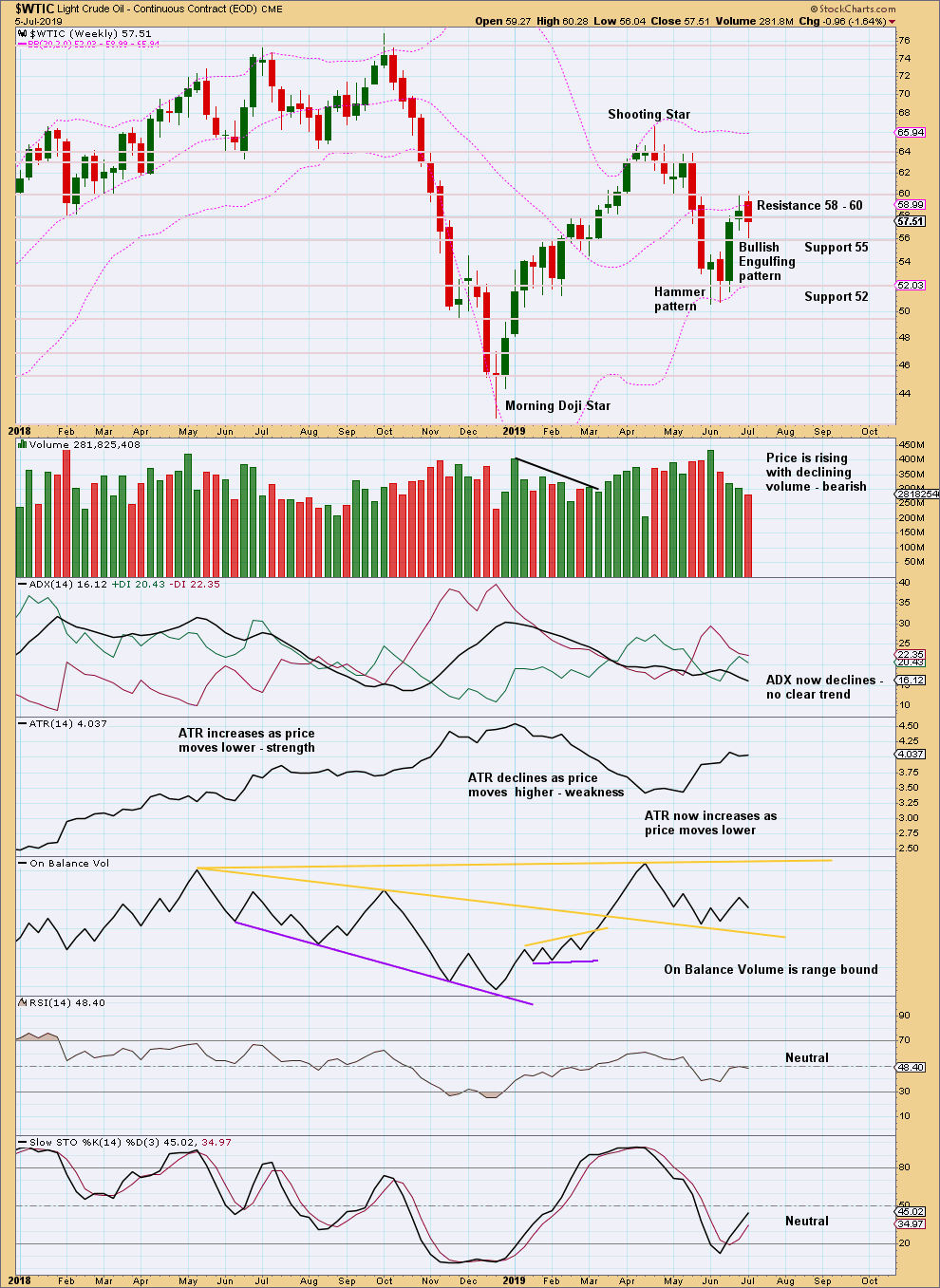
Click chart to enlarge. Chart courtesy of StockCharts.com.
An outside week closes red with the balance of volume downwards. Volume during the week did not push price lower.
DAILY CHART

Click chart to enlarge. Chart courtesy of StockCharts.com.
For the bounce up to the last high volume and ATR declined, suggesting the movement was a counter trend movement.
Now price has pulled back with a little push from volume. It is possible the bounce could be over.
For the very short term, a little support from volume for upwards movement within Friday’s session suggests more upwards movement to begin next week.
—
Always practice good risk management as the most important aspect of trading. Always trade with stops and invest only 1-5% of equity on any one trade. Failure to manage risk is the most common mistake new traders make.

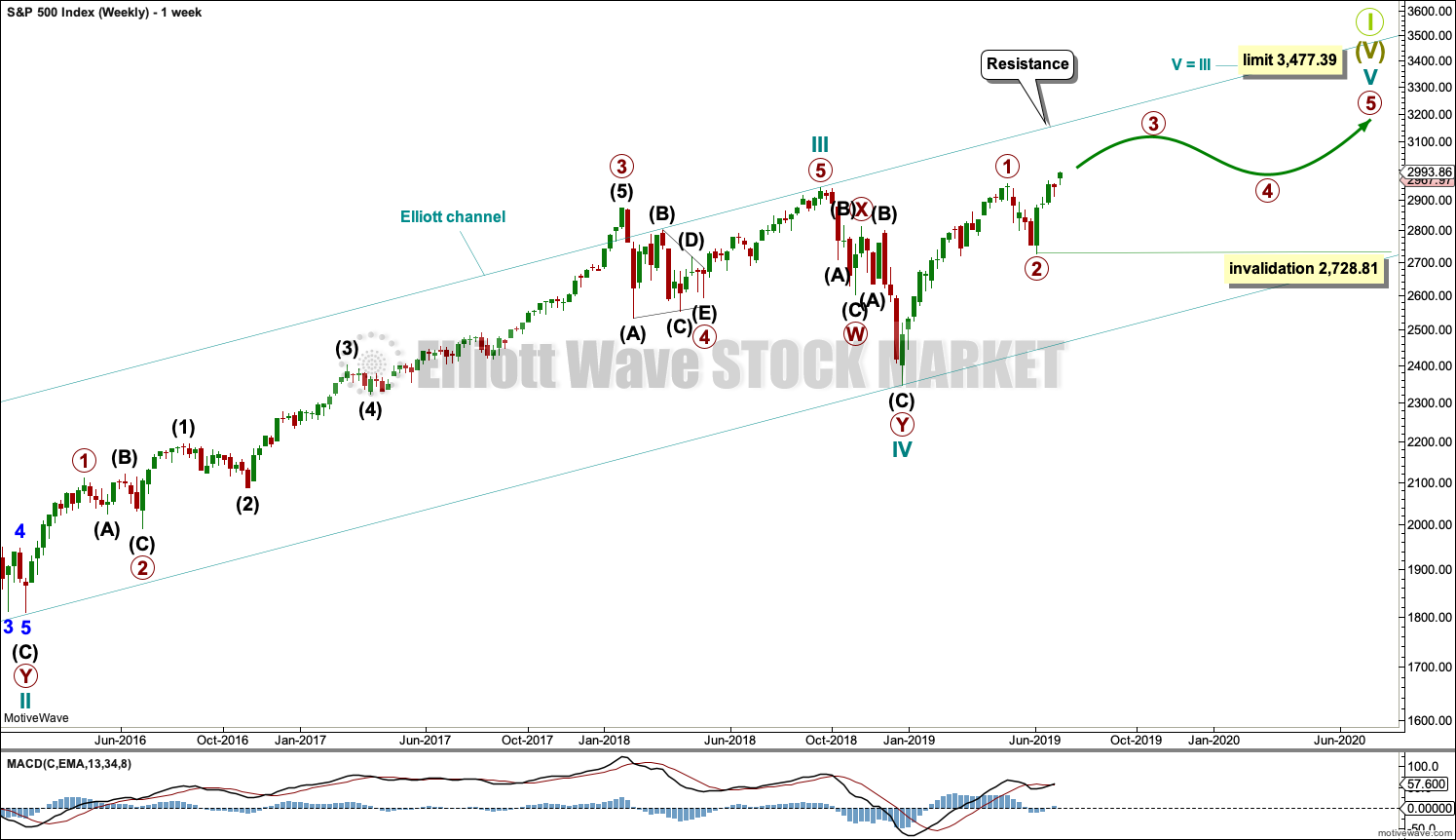
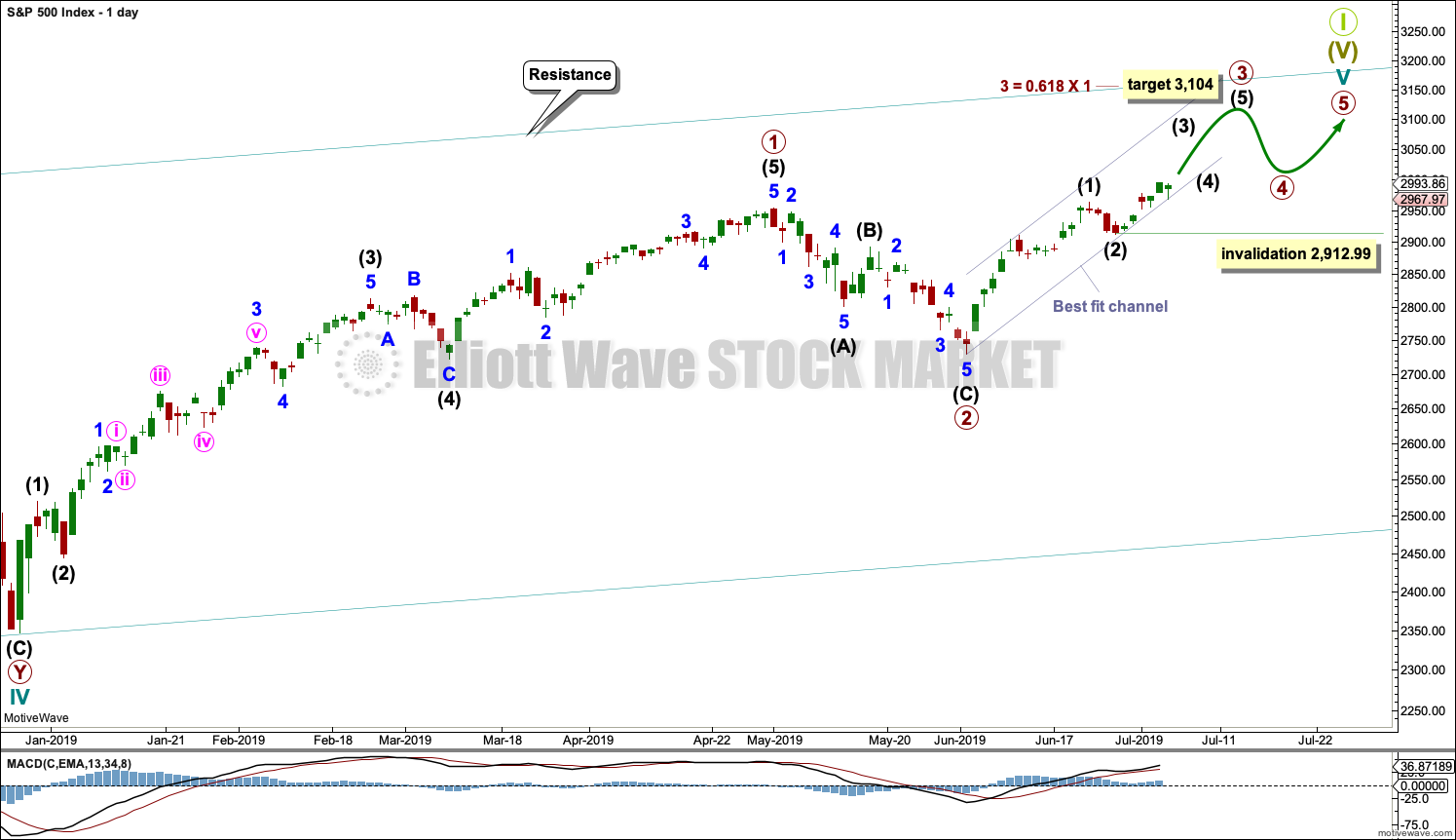
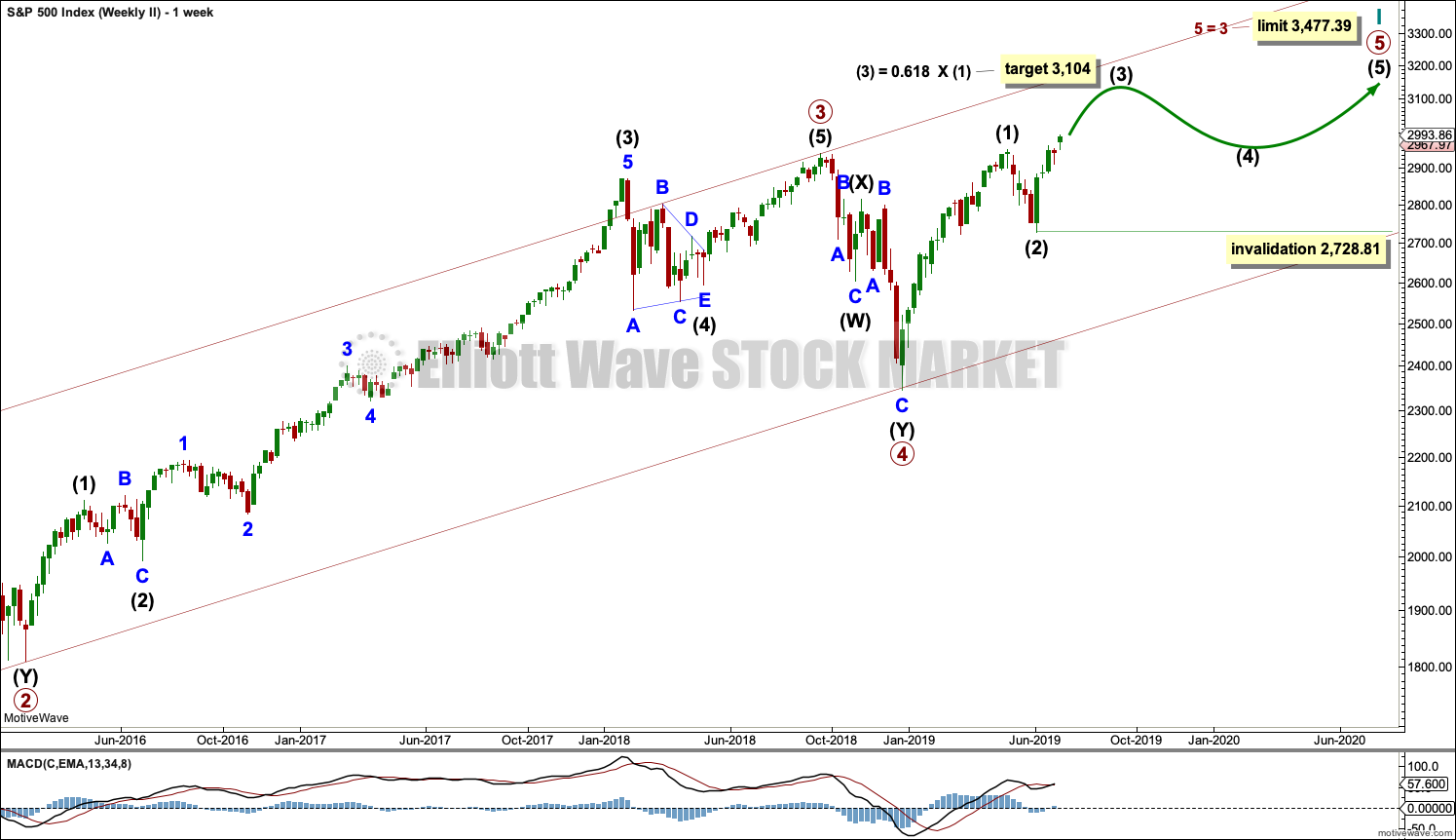
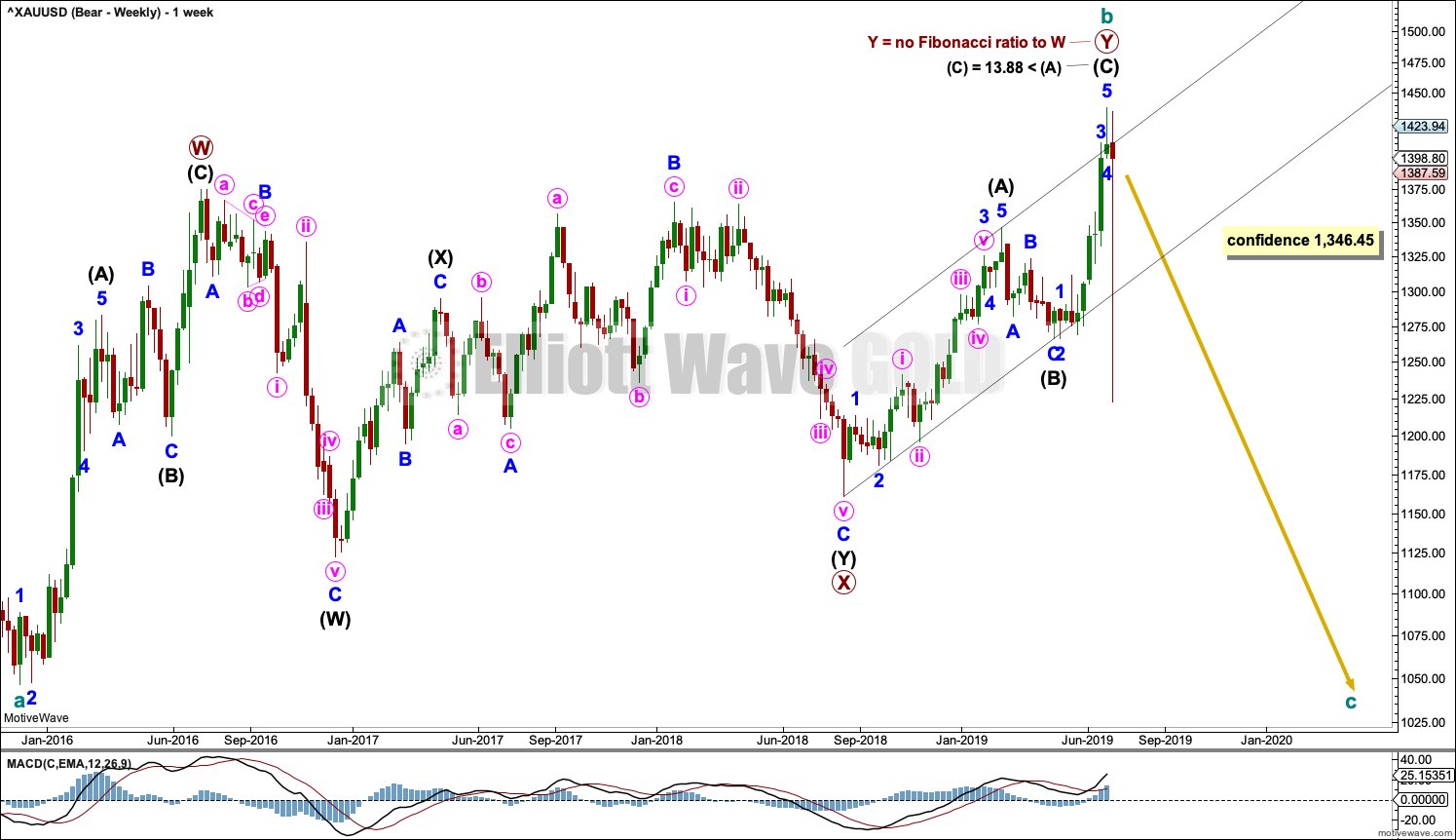

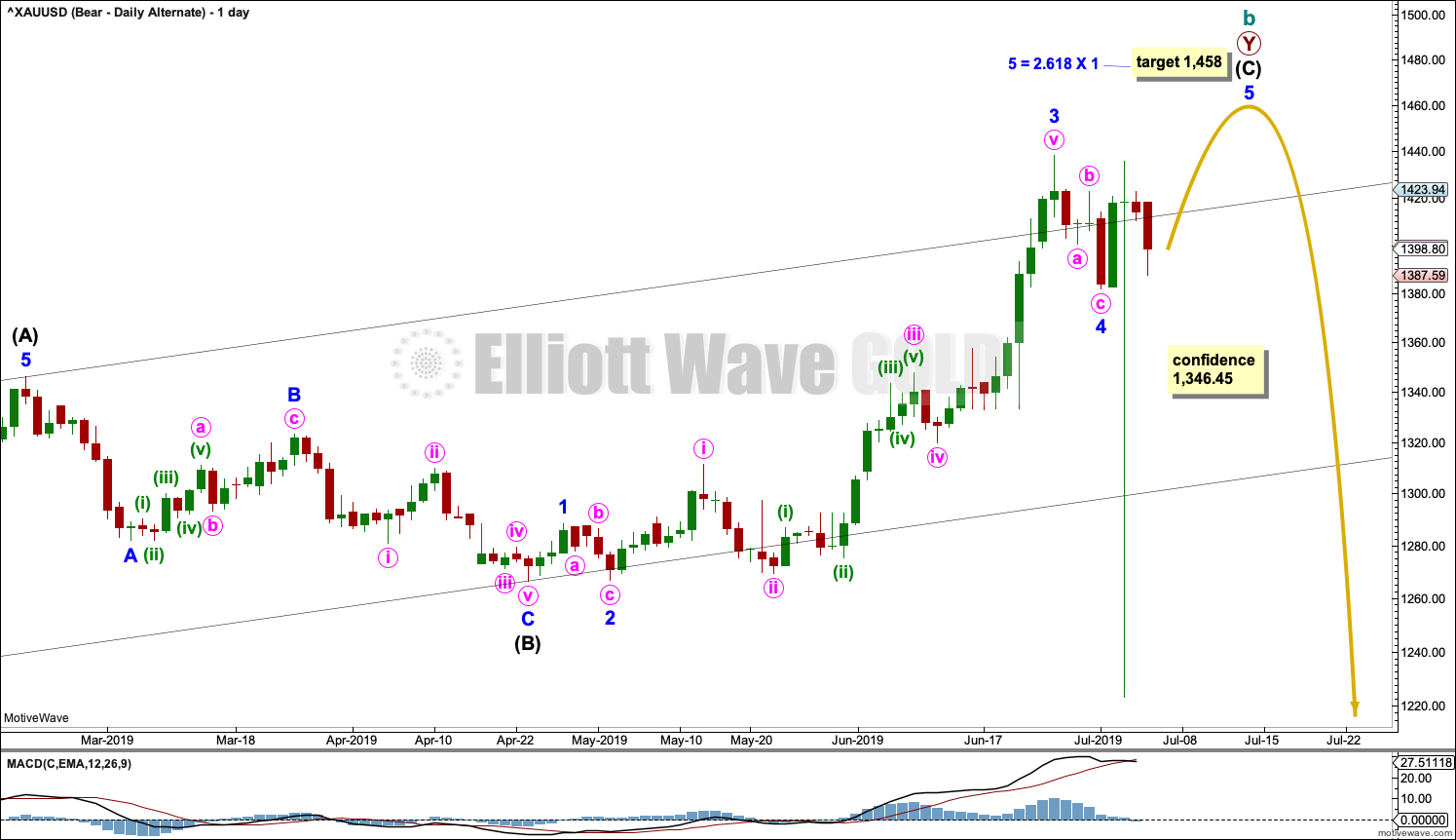
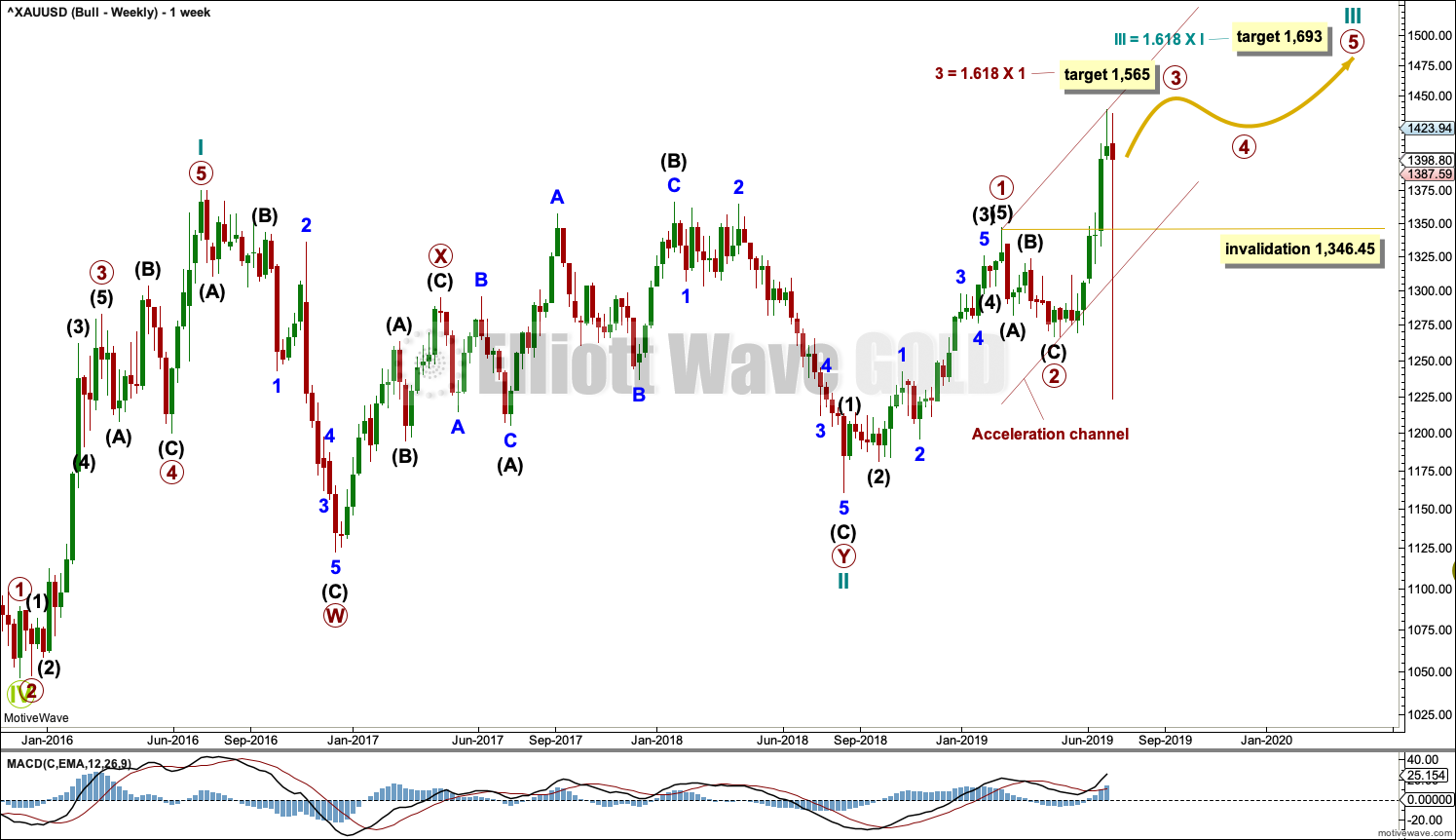
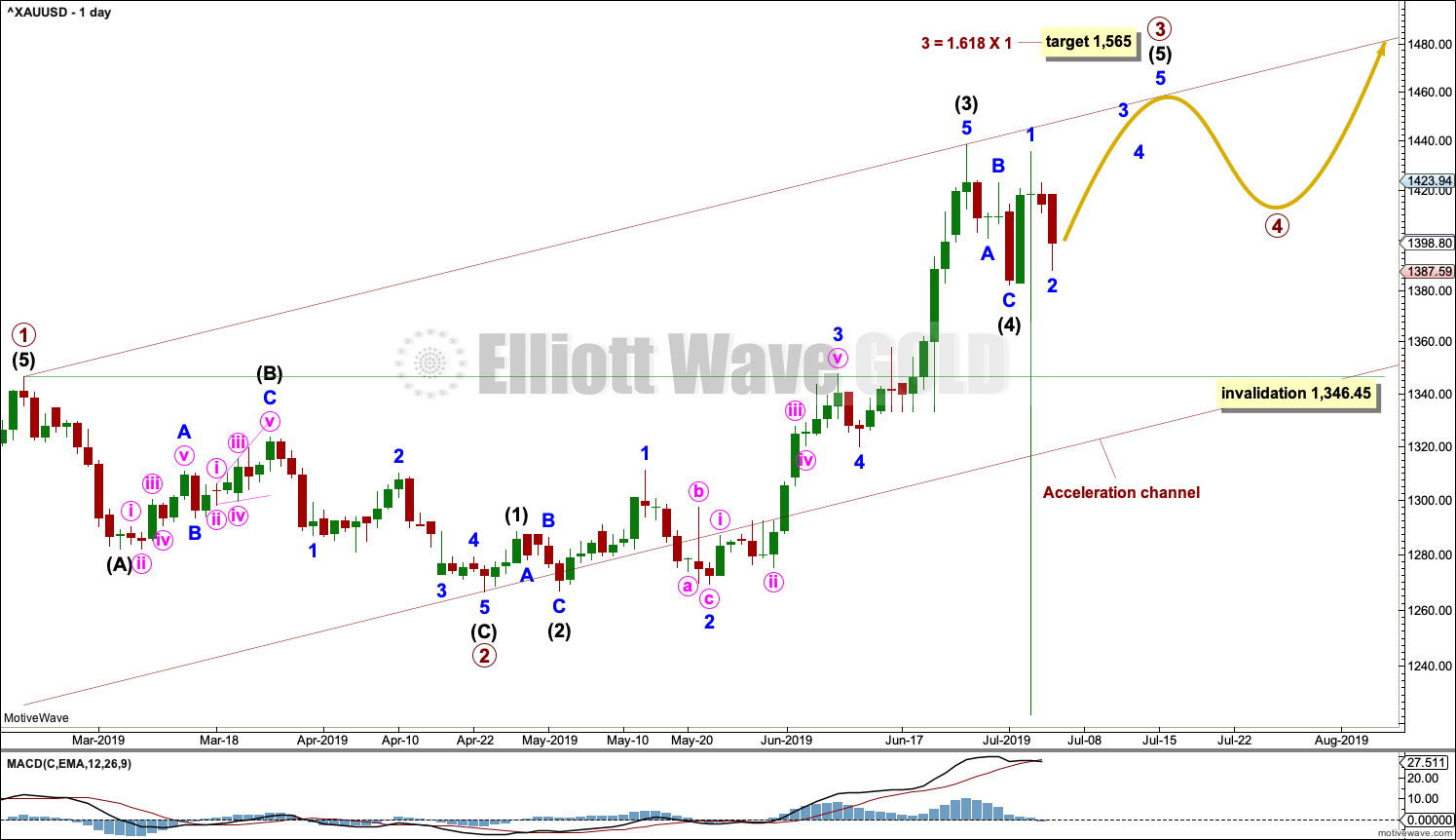
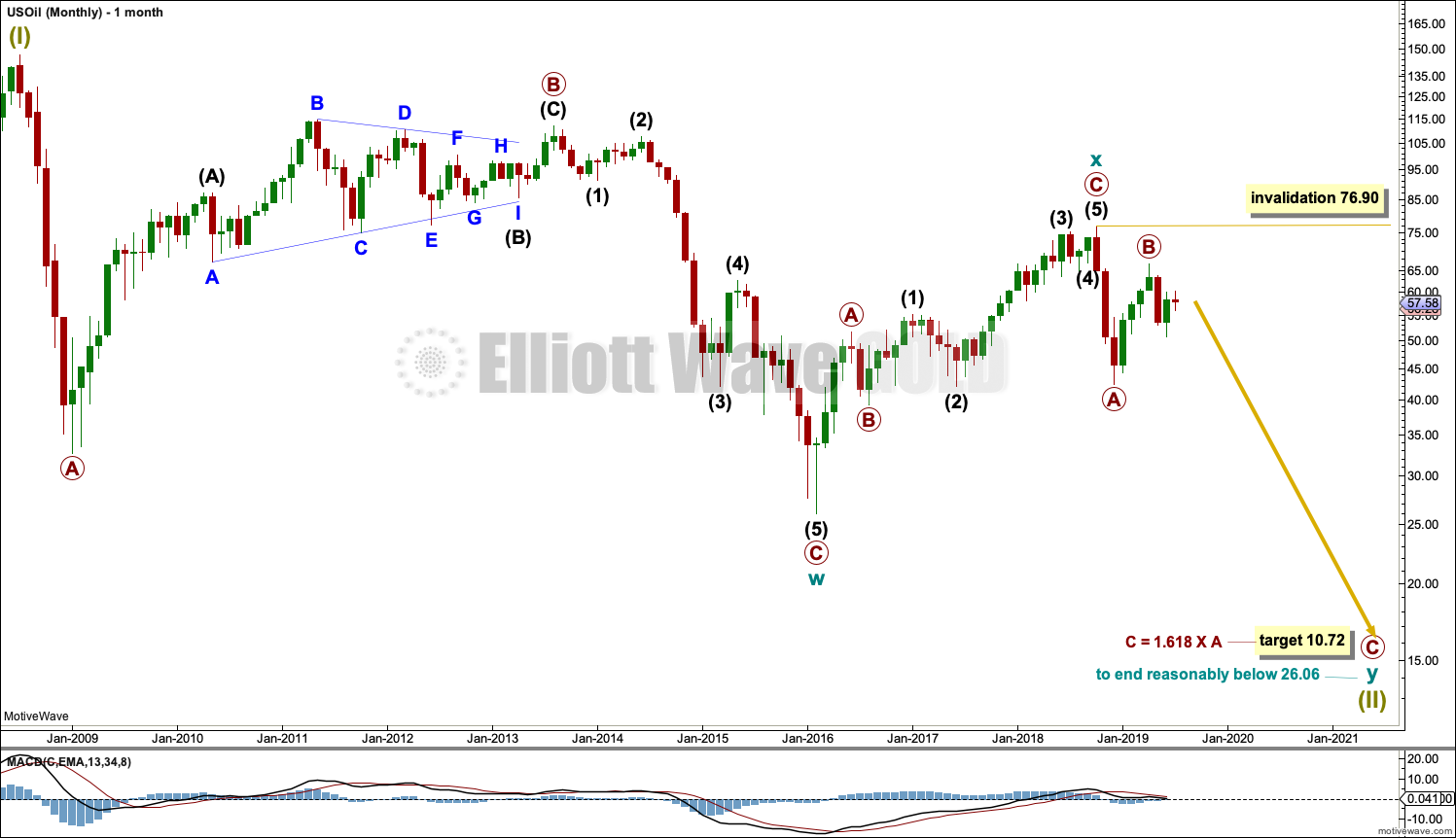
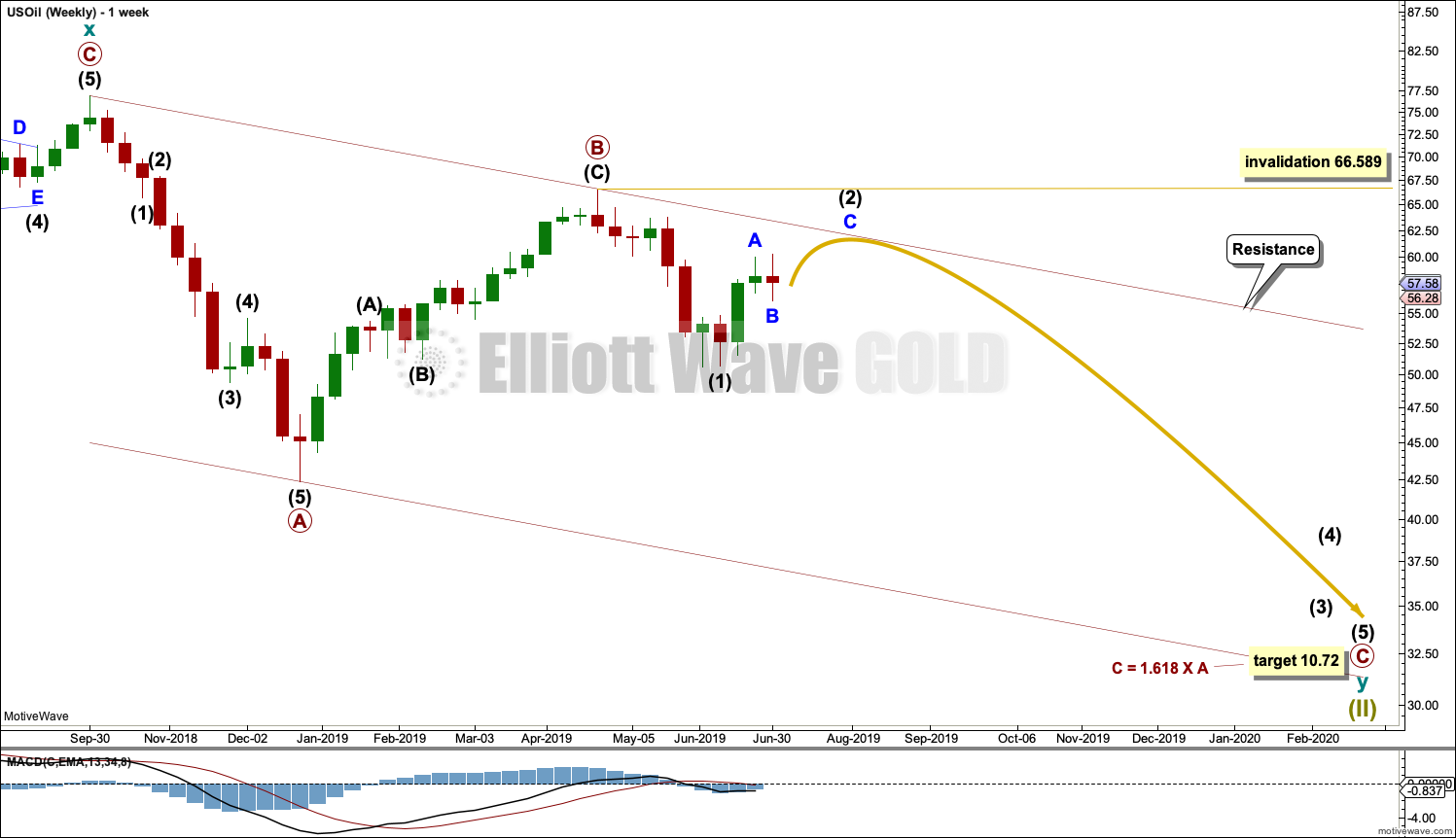
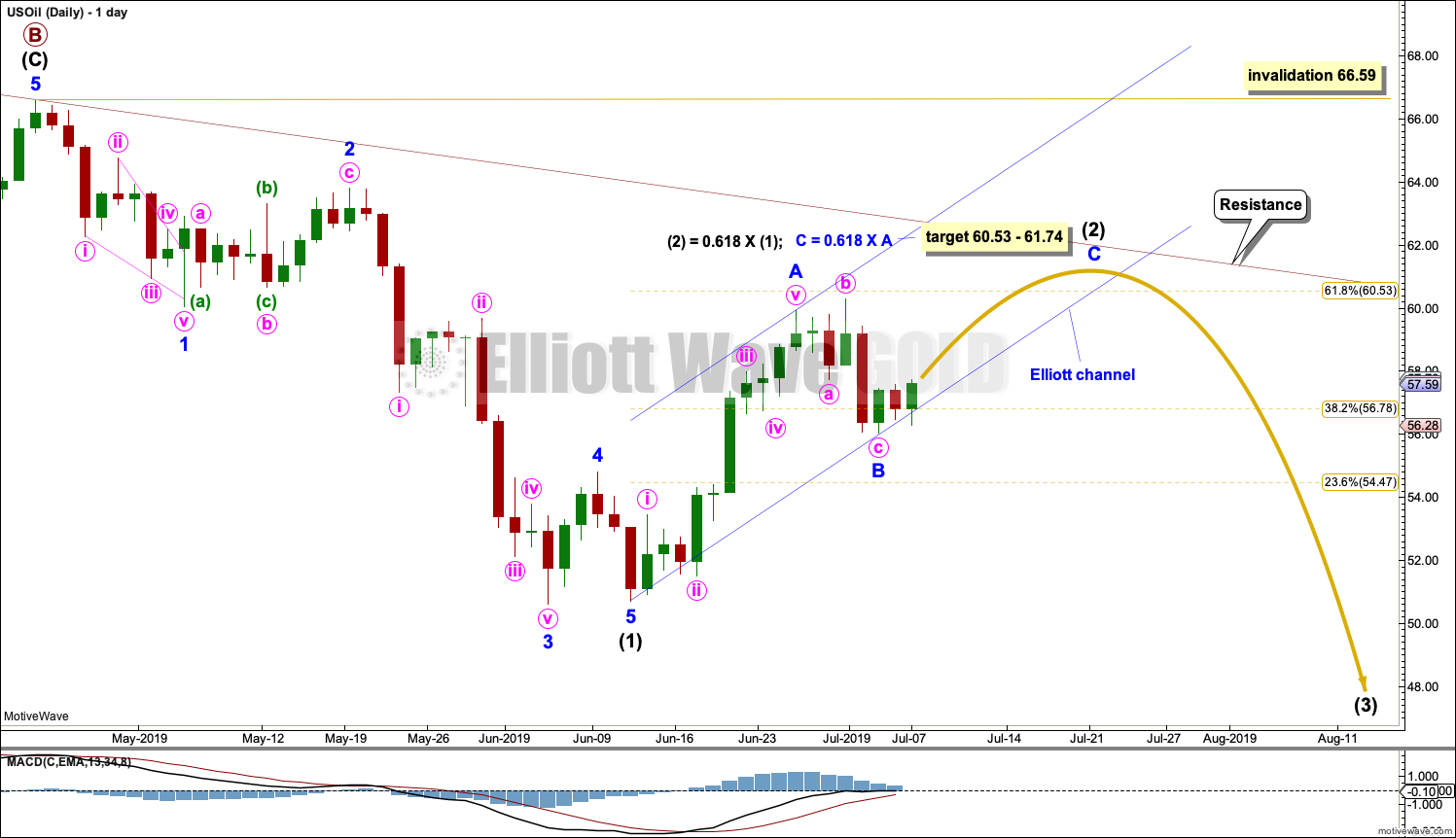
Hi Lara,
I’m simply curious if you have a bullish US Oil count that is possible?
The oil markets can easily shift in sentiment, and with futures trading in backwardation (normal for a bull market), I’m wondering if there’s a reasonable chance that oil is heading into a more bullish phase.
I also realize its entering the perfect sell zone within your main count – I’m staying open to both possibilities.
Thank you!
Corey
The only one I have moves the degree of labelling within cycle x down one degree and sees cycle x as a double zigzag. That’s a very low probability and not supported by my technical analysis which is why I haven’t published it.
I’m working on what a bullish count may look like, if it’s okay I may publish it today. Or not. Unsure.
Awesome thank you!
Updated daily chart for the S&P500:
Today price breached the support line on the best fit channel that I had drawn. That prompted me to take a blank hourly chart and relabel primary wave 3.
It looks like an impulse was complete at the last high. I do not want to label that primary wave 3 over in its entirety, because there would not be enough room for primary wave 4 to unfold and remain above primary wave 1 price territory. So I’m looking at this impulse as only intermediate (1) within primary wave 3.
Now I expect intermediate (2) to continue as a shallow pullback or consolidation to last about two more weeks, maybe to total a Fibonacci 13 sessions at its end. So far its lasted 2 sessions. The target for intermediate (2) is about 2,933.
From a Weekly Subscriber, thank you for the midweek analysis. Perhaps it’s the potentially historical pivot point that we are at which makes the dynamics of how this unfolds so engaging. Looking forward to how you will review the week. Looking forward, too, to what the S&P 500 Grand Super Cycle Yearly Chart might look like given the Second Wave count perspective.
Thanks, that’s a good point. I think its time to update my Grand Super Cycle analysis.